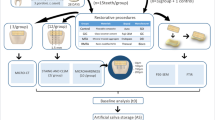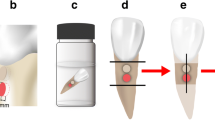Abstract
Objectives
This study was designed to adapt a previously developed in vitro microcosm biofilm model to create carries-affected dentin (CAD) and establish conditions for using the model in bonding studies.
Materials and methods
Biofilms were originated from human saliva and grown on dentin discs for 0 (sound dentin), 3, 5, 7, 14, or 21 days under intermittent cariogenic condition (n = 10). At each time point, composite cylinders were bonded to the dentin using self-etch adhesive (Clearfil SE Bond). The response variables were integrated mineral loss (ΔS), lesion depth (LD), shear bond strength (SBS), and failure mode. Data were statistically analyzed (α = 0.05). Bonded interfaces were analyzed by scanning electron microscopy (SEM), and dentin surfaces characterized by infrared spectroscopy (Fourier transform infrared spectroscopy, FTIR).
Results
Lower ΔS was found for sound dentin than for CAD in all experimental groups, except for the group under cariogenic challenge for 3 days. The SBS to CAD was significantly lower than control for all cariogenic challenge times. Adhesive failures were predominant in all groups. ΔS and LD had a significant negative correlation with SBS. A significant exponential decay in SBS was associated with increased ΔS values. CAD had lower mineral and amide I content and an irregular hybridization interface compared to sound dentin.
Conclusions
The microcosm biofilm model was able to artificially induce CAD, which imposed challenge to the bonding of the polymeric adhesive material.
Clinical relevance
Presence of CAD might interfere with the bonding of polymeric materials. The microcosm biofilm model proposed could be useful for preclinical dentin bonding studies.




Similar content being viewed by others
References
Selwitz RH, Ismail AI, Pitts NB (2007) Dental caries. Lancet 369:51–59. doi:10.1016/s0140-6736(07)60031-2
Maltz M, Oliveira EF, Fontanella V, Carminatti G (2007) Deep caries lesions after incomplete dentine caries removal: 40-month follow-up study. Caries Res 41:493–496. doi:10.1159/000109349
Perdigao J (2010) Dentin bonding-variables related to the clinical situation and the substrate treatment. Dent Mater 26:e24–e37. doi:10.1016/j.dental.2009.11.149
Say EC, Nakajima M, Senawongse P, Soyman M, Ozer F, Tagami J (2005) Bonding to sound vs caries-affected dentin using photo- and dual-cure adhesives. Oper Dent 30:90–98
Wei S, Sadr A, Shimada Y, Tagami J (2008) Effect of caries-affected dentin hardness on the shear bond strength of current adhesives. J Adhes Dent 10:431–440
Joves GJ, Inoue G, Nakashima S, Sadr A, Nikaido T, Tagami J (2013) Mineral density, morphology and bond strength of natural versus artificial caries-affected dentin. Dent Mater J 32:138–143. doi:10.4012/dmj.2012-243
Daculsi G, LeGeros RZ, Jean A, Kerebel B (1987) Possible physico-chemical processes in human dentin caries. J Dent Res 66:1356–1359
Nakashima S, Yoshie M, Sano H, Bahar A (2009) Effect of a test dentifrice containing nano-sized calcium carbonate on remineralization of enamel lesions in vitro. J Oral Sci 51:69–77
Ogawa K, Yamashita Y, Ichijo T, Fusayama T (1983) The ultrastructure and hardness of the transparent layer of human carious dentin. J Dent Res 62:7–10
Marshall GW, Habelitz S, Gallagher R, Balooch M, Balooch G, Marshall SJ (2001) Nanomechanical properties of hydrated carious human dentin. J Dent Res 80:1768–1771
Nakajima M, Kunawarote S, Prasansuttiporn T, Tagami J (2011) Bonding to caries-affected dentin. Japan Dent Sci Rev 47:102–114. doi:10.1016/j.jdsr.2011.03.002
Suzuki TY, Godas AG, Guedes AP, Catelan A, Pavan S, Briso AL, Dos Santos PH (2013) Microtensile bond strength of resin cements to caries-affected dentin. J Prosthet Dent 110:47–55. doi:10.1016/S0022-3913(13)60339-X, S0022-3913(13)60339-X [pii]
Zanchi CH, D'Avila OP, Rodrigues-Junior SA, Burnett LH Jr, Demarco FF, Pinto MB (2010) Effect of additional acid etching on bond strength and structural reliability of adhesive systems applied to caries-affected dentin. J Adhes Dent 12:109–115. doi:10.3290/j.jad.a17529
Erhardt MC, Rodrigues JA, Valentino TA, Ritter AV, Pimenta LA (2008) In vitro microTBS of one-bottle adhesive systems: sound versus artificially-created caries-affected dentin. J Biomed Mater Res B Appl Biomater 86:181–187. doi:10.1002/jbm.b.31004
Marquezan M, Correa FN, Sanabe ME, Rodrigues Filho LE, Hebling J, Guedes-Pinto AC, Mendes FM (2009) Artificial methods of dentine caries induction: a hardness and morphological comparative study. Arch Oral Biol 54:1111–1117. doi:10.1016/j.archoralbio.2009.09.007
Rocha C, Faria ESA, Peixoto A (2013) Bond strength of adhesive luting agents to caries-affected dentin. Oper Dent. doi:10.2341/2313-2062-L
van de Sande FH, Azevedo MS, Lund RG, Huysmans MC, Cenci MS (2011) An in vitro biofilm model for enamel demineralization and antimicrobial dose-response studies. Biofouling 27:1057–1063. doi:10.1080/08927014.2011.625473
Clarkson BH, Wefel JS, Miller I (1984) A model for producing caries-like lesions in enamel and dentin using oral bacteria in vitro. J Dent Res 63:1186–1189
Ricci HA, Scheffel DL, Mariusso MR, Spolidorio DM, Costa CA, Hebling J (2013) Exposed collagen in resin bonds to caries-affected dentin after dentin treatment with aqueous and alcoholic chlorhexidine solutions. J Adhes Dent. doi:10.3290/j.jad.a30716
Sanabe ME, Costa CA, Hebling J (2011) Exposed collagen in aged resin-dentin bonds produced on sound and caries-affected dentin in the presence of chlorhexidine. J Adhes Dent 13:117–124. doi:10.3290/j.jad.a19239
Wong L, Sissons C (2001) A comparison of human dental plaque microcosm biofilms grown in an undefined medium and a chemically defined artificial saliva. Arch Oral Biol 46:477–486
Yip HK, Guo J, Wong WH (2007) Protection offered by root-surface restorative materials against biofilm challenge. J Dent Res 86:431–435
Magne D, Weiss P, Bouler JM, Laboux O, Daculsi G (2001) Study of the maturation of the organic (type I collagen) and mineral (nonstoichiometric apatite) constituents of a calcified tissue (dentin) as a function of location: a Fourier transform infrared microspectroscopic investigation. J Bone Miner Res 16:750–757. doi:10.1359/jbmr.2001.16.4.750
Penel G, Leroy G, Rey C, Bres E (1998) MicroRaman spectral study of the PO4 and CO3 vibrational modes in synthetic and biological apatites. Calcif Tissue Int 63:475–481
Navarra CO, Cadenaro M, Armstrong SR, Jessop J, Antoniolli F, Sergo V, Di Lenarda R, Breschi L (2009) Degree of conversion of Filtek Silorane Adhesive System and Clearfil SE Bond within the hybrid and adhesive layer: an in situ Raman analysis. Dent Mater 25:1178–1185. doi:10.1016/j.dental.2009.05.009
Sousa RP, Zanin IC, Lima JP, Vasconcelos SM, Melo MA, Beltrao HC, Rodrigues LK (2009) In situ effects of restorative materials on dental biofilm and enamel demineralisation. J Dent 37:44–51. doi:10.1016/j.jdent.2008.08.009
McBain AJ (2009) Chapter 4 In vitro biofilm models: an overview. Adv Appl Microbiol 69:99–132. doi:10.1016/s0065-2164(09)69004-3
Tang G, Yip HK, Cutress TW, Samaranayake LP (2003) Artificial mouth model systems and their contribution to caries research: a review. J Dent 31:161–171. doi:10.1016/s0300-5712(03)00009-5
Filoche SK, Soma KJ, Sissons CH (2007) Caries-related plaque microcosm biofilms developed in microplates. Oral Microbiol Immunol 22:73–79. doi:10.1111/j.1399-302X.2007.00323.x
Filoche SK, Soma D, van Bekkum M, Sissons CH (2008) Plaques from different individuals yield different microbiota responses to oral-antiseptic treatment. Fems Immunol Med Microbiol 54:27–36. doi:10.1111/j.1574-695X.2008.00443.x
Azevedo MS, Van De Sande FH, Romano AR, Cenci MS (2011) Microcosm biofilms originating from children with different caries experience have similar cariogenicity under successive sucrose challenges. Caries Res 45:510–517
Zaura E, Buijs MJ, Hoogenkamp MA, Ciric L, Papetti A, Signoretto C, Stauder M, Lingstrom P, Pratten J, Spratt DA, Wilson M (2011) The effects of fractions from shiitake mushroom on composition and cariogenicity of dental plaque microcosms in an in vitro caries model. J Biomed Biotechnol 2011:135034. doi:10.1155/2011/135034
May-Lei M, Chun-Hung C, Chin-Man LE, Lakshman-Perera S (2013) Preventing root caries development under oral biofilm challenge in an artificial mouth. Med Oral Patol Oral Cirug Bucal e557-e563. doi: 10.4317/medoral.18768
Yoshiyama M, Tay FR, Doi J, Nishitani Y, Yamada T, Itou K, Carvalho RM, Nakajima M, Pashley DH (2002) Bonding of self-etch and total-etch adhesives to carious dentin. J Dent Res 81:556–560. doi:10.1177/154405910208100811
Kelly JR, Benetti P, Rungruanganunt P, Bona AD (2012) The slippery slope: critical perspectives on in vitro research methodologies. Dent Mater 28:41–51. doi:10.1016/j.dental.2011.09.001
Acknowledgments
The authors would like to acknowledge the assistance in the experiments from Katielle Brauner, Fradane Braz, and Carmen Lúcia Machado Lopes.
Conflict of interest
The authors declare that they have no conflicts of interest associated with the manuscript.
Author information
Authors and Affiliations
Corresponding author
Rights and permissions
About this article
Cite this article
Maske, T.T., Isolan, C.P., van de Sande, F.H. et al. A biofilm cariogenic challenge model for dentin demineralization and dentin bonding analysis. Clin Oral Invest 19, 1047–1053 (2015). https://doi.org/10.1007/s00784-014-1331-1
Received:
Accepted:
Published:
Issue Date:
DOI: https://doi.org/10.1007/s00784-014-1331-1




